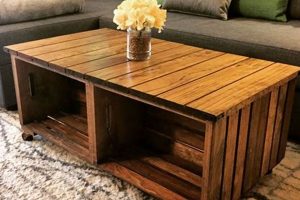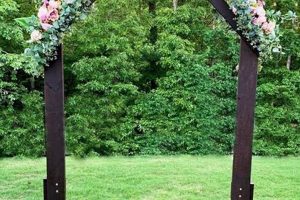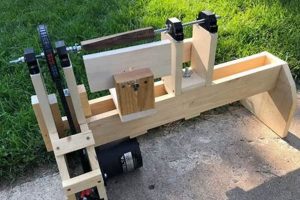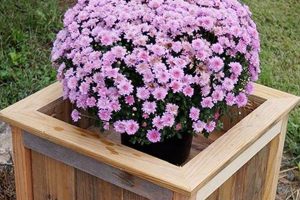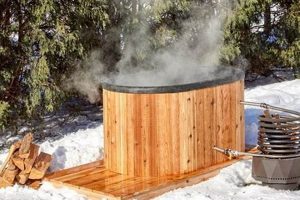A structure, typically crafted from lumber, designed to support climbing plants in gardens or landscapes. These supports, often assembled by the individual user, provide a framework for vines and other flora to ascend vertically. For example, a homemade grid constructed from cedar boards and secured to a garden wall allows roses or clematis to flourish.
The integration of such elements enhances outdoor spaces aesthetically and functionally. These structures offer an alternative to ground-based growth, maximizing spatial efficiency, particularly in smaller areas. Historically, these plant supports have been utilized to cultivate food crops, providing both structural assistance and increased yield. Their enduring appeal lies in their cost-effectiveness, customization options, and the satisfaction derived from hands-on creation.
The subsequent discussion will explore various designs, material selection considerations, and construction techniques for erecting these plant-support frameworks, enabling readers to implement similar projects. Topics covered will include wood selection, joinery methods, finishing techniques, and installation strategies suitable for diverse environments.
Construction and Application Guidance
The following guidance outlines fundamental principles for constructing durable and aesthetically pleasing plant-support structures, enhancing both the structural integrity and visual appeal of gardens and landscapes.
Tip 1: Material Selection: Prioritize rot-resistant lumber such as cedar, redwood, or pressure-treated pine. This minimizes degradation from moisture and extends the structure’s lifespan. Consider local climate conditions and soil composition when selecting appropriate materials.
Tip 2: Design Planning: Develop a comprehensive design plan that considers the mature size and weight of the intended climbing plant. Ensure the structure is adequately sized to support the plants growth without becoming structurally compromised.
Tip 3: Joint Integrity: Employ robust joinery techniques such as mortise-and-tenon, lap joints, or pocket-hole screws. These methods provide greater structural stability compared to simple butt joints, particularly under the load of a mature plant.
Tip 4: Protective Finishing: Apply a weather-resistant sealant or paint to protect the wood from moisture, UV damage, and insect infestation. Regularly inspect and reapply the finish as needed to maintain its protective properties.
Tip 5: Secure Anchoring: Anchor the structure securely to the ground or an existing structure to prevent tipping or collapse. Use appropriate anchoring hardware such as ground stakes, screws, or concrete footings depending on the size and location.
Tip 6: Consider Plant Access: Design the structure to allow easy access for pruning, training, and harvesting plants. Adequate spacing between supports facilitates plant management and reduces the risk of damage.
Tip 7: Drainage Considerations: Ensure adequate drainage around the base of the structure to prevent water accumulation and wood rot. Elevate the structure slightly off the ground to promote airflow and minimize moisture contact.
Adherence to these principles ensures the creation of a stable, long-lasting structure that effectively supports plant growth and enhances the overall aesthetic of the garden or landscape.
The subsequent sections will elaborate on specific design patterns and advanced construction techniques for creating customized vertical growing solutions.
1. Material Durability
Material durability is a primary determinant of the lifespan and performance of any plant support. The structural integrity and resistance to environmental degradation dictate its suitability for long-term use. Selection of appropriate materials directly affects the frequency of repairs, replacement costs, and overall effectiveness in supporting plant growth.
- Resistance to Rot and Decay
The capacity of wood to withstand fungal decay and rot is paramount, especially in humid environments. Untreated lumber is highly susceptible to microbial degradation, leading to structural weakening and eventual failure. Species such as cedar and redwood possess natural oils that inhibit fungal growth, while pressure-treated lumber undergoes a chemical process to resist decay.
- Resistance to Insect Infestation
Certain wood-boring insects can compromise structural integrity. Species like termites and carpenter bees tunnel through wood, weakening the framework. Pressure-treated lumber often incorporates insecticides that deter these pests. Regular inspection and preventative treatments may be necessary to mitigate the risk of infestation, even with naturally resistant species.
- Weather Resistance
Exposure to sunlight, rain, and temperature fluctuations causes weathering. Ultraviolet (UV) radiation degrades lignin, a component of wood, leading to surface erosion and color fading. Moisture absorption promotes swelling and contraction, potentially causing warping or cracking. Applying protective coatings such as paints, stains, or sealants helps to shield the wood from the elements.
- Structural Strength Under Load
The wood’s capacity to support the weight of mature climbing plants is critical. Different wood species possess varying tensile and compressive strengths. Softer woods may deflect or break under heavy loads, requiring reinforcement or alternative designs. Proper joinery techniques and adequate support spacing are essential to distribute the weight effectively and prevent structural failure.
These interlinked properties underscore the importance of selecting materials that combine inherent resistance to degradation with sufficient structural strength. Utilizing durable materials minimizes long-term maintenance and ensures the plant support effectively fulfills its intended function, providing a stable and aesthetically pleasing framework for supporting plant life.
2. Structural Integrity
Structural integrity, in the context of a plant-support framework, directly correlates to its capacity to withstand applied loads without failure or significant deformation. The connection to homemade plant-support structures is fundamental, as the longevity and effectiveness depend entirely on its robust construction. Inadequate structural design or poor execution inevitably results in collapse under the weight of mature plants or adverse weather conditions. The choice of joinery techniques, the quality of materials, and the overall design contribute to this integrity. As a clear example, consider a simple butt joint secured with nails. While initially adequate for lighter plants, this joint will likely fail under the stress of a heavy vine or strong winds, leading to structural instability and potential damage to the plant itself.
The practical significance of understanding structural integrity lies in the ability to create safe and reliable plant supports. Proper joint construction, such as mortise-and-tenon or lap joints, significantly increases load-bearing capacity and resistance to racking. Furthermore, the selection of appropriate wood species, known for their strength and resistance to decay, contributes to long-term structural stability. For example, a homemade structure built with pressure-treated lumber and secured with sturdy joints will provide a robust framework for climbing plants for many years, minimizing the risk of collapse and associated hazards. Regular inspection and maintenance, including reinforcing weak points and reapplying protective coatings, will further extend its lifespan and preserve its structural integrity.
In summary, the connection between structural integrity and homemade plant-support structures is inextricable. A well-designed and carefully constructed structure ensures the safe and effective support of plants, contributing to a flourishing garden and minimizing maintenance. The absence of structural integrity invites premature failure and negates the benefits intended by the creation. Challenges in ensuring structural integrity arise from the variability in wood quality, the complexity of joinery, and the need for consistent maintenance, all of which require careful attention to detail throughout the planning and building process.
3. Design Aesthetics
The visual appeal of a homemade plant support is often as critical as its functionality. Design aesthetics significantly impact the integration of the structure within the landscape, influencing the overall harmony and perceived value of the garden. A structures aesthetic qualities should complement both the surrounding environment and the climbing plants it supports.
- Material Choice and Color Palette
Material selection directly influences the visual character. Natural wood finishes, such as stains, highlight the grain and provide a rustic aesthetic. Painted finishes offer opportunities for vibrant colors or a more formal appearance. The chosen color palette should harmonize with existing landscape elements, including fences, buildings, and plant foliage. A poorly chosen color can detract from the overall visual coherence of the garden.
- Form and Proportion
The shape and dimensions of the plant support influence its visual weight and balance within the garden. Simple geometric shapes, such as squares or rectangles, provide a clean and modern look. Arched or curved designs add a touch of elegance. The proportions should be appropriate for the scale of the climbing plants and the surrounding space. An oversized structure can overwhelm a small garden, while an undersized trellis may appear insignificant.
- Pattern and Texture
The pattern created by the framework contributes to the overall visual interest. Regular grids offer a structured and organized appearance. Interwoven or irregular patterns can create a more naturalistic effect. Texture also plays a role, with rough-sawn lumber providing a rustic feel and smooth, planed surfaces offering a more refined look. The pattern and texture should complement the plant’s foliage, creating a visually pleasing contrast or harmony.
- Integration with Surrounding Elements
The plant supports design should consider its relationship to other landscape features. Aligning the structure with existing architectural lines creates a sense of order. Incorporating the trellis into a larger garden design, such as a border planting or a focal point, enhances its impact. The overall goal is to create a cohesive and visually appealing composition that integrates the structure seamlessly into its environment.
In conclusion, the connection between design aesthetics and homemade plant-support frameworks is integral to enhancing outdoor spaces. Thoughtful material selection, proportional form, considered patterns, and seamless integration contribute to a visually compelling and harmonious garden environment. The overall design should reflect both the functional requirements of plant support and the desired aesthetic of the surrounding landscape.
4. Plant Support
The primary function of a plant support structure is to facilitate the vertical growth of climbing plants. The connection between this function and a timber framework manifests directly in the ability of the structure to bear the weight of the mature plant, provide adequate surface area for tendrils or stems to attach, and maintain its structural integrity throughout the plant’s life cycle. A poorly designed or constructed support can impede plant growth, lead to structural failure, or compromise the aesthetic integration of the structure within the garden. For example, a homemade structure constructed with inadequate spacing between vertical members may restrict plant growth, while a structure lacking sufficient anchoring may topple under the weight of a mature vine.
A direct consequence of implementing suitable plant support structures is the enhanced cultivation of climbing plants. The presence of a robust framework allows for improved airflow around the plant, reducing the risk of fungal diseases. It also enables better sunlight penetration, promoting more vigorous growth and increased yields for edible plants. The design of the plant support can be tailored to specific plant needs, providing optimal conditions for growth and flowering. For example, a horizontal framework can be used to espalier fruit trees, maximizing sunlight exposure and facilitating easier harvesting. Selecting durable and weather-resistant materials contributes to the long-term performance and aesthetic appeal of the structure.
In summary, the effectiveness of a homemade timber framework relies on its ability to provide robust and tailored plant support. Considerations regarding material selection, structural design, and plant-specific requirements are essential for creating a successful and sustainable growing environment. The challenges in achieving this outcome include adapting designs to diverse plant species, maintaining structural integrity over time, and integrating the structure harmoniously within the garden setting. Understanding these relationships is crucial for effective gardening practices and sustainable outdoor design.
5. Spatial Efficiency
Spatial efficiency, in the context of plant cultivation, refers to maximizing plant yield or aesthetic impact within a limited area. Plant supports are instrumental in achieving this, especially in urban gardens or smaller landscapes where horizontal space is restricted. The implementation of vertical structures allows for a greater concentration of plants than traditional ground-based gardening. The connection between plant support framework and spatial efficiency is a direct one: by providing a vertical growth plane, the structure exponentially increases the potential growing area without expanding the garden’s footprint. Examples include the cultivation of climbing vegetables such as cucumbers or pole beans in a small backyard, or the creation of a green wall in an urban balcony. The practical significance of understanding this connection is that it enables gardeners to optimize their use of available space, increasing productivity and aesthetic appeal.
An important design consideration involves adapting the structure’s dimensions to the specific needs of the climbing plants. The structure’s height, width, and depth must accommodate the mature size of the plants. Implementing designs that allow for customization and adjustments enables gardeners to optimize plant density and maximize yield. For instance, a modular design allows for easy expansion or reconfiguration as plants mature, while a framework with adjustable support members can be adapted to different species. Integrating vertical gardening systems with other space-saving techniques, such as container gardening or raised beds, further optimizes the use of limited areas. Real-world examples showcase how this concept can transform small spaces into productive food-producing areas or tranquil, aesthetically pleasing environments.
In summary, the relationship between spatial efficiency and plant support highlights the benefits of vertical gardening in maximizing limited growing areas. Tailoring designs to specific plant needs and integrating vertical gardening with other space-saving techniques contributes to productive and aesthetically pleasing garden environments. Challenges in achieving spatial efficiency may include selecting appropriate plant species for vertical growth, ensuring adequate structural support for mature plants, and maintaining sufficient sunlight exposure for all plants within the framework. Understanding these factors enables gardeners to create efficient and sustainable growing spaces.
6. Weather Resistance
Weather resistance is a critical factor determining the longevity and performance of any outdoor structure, particularly a homemade plant support. Exposure to environmental elements, such as sunlight, rain, and temperature fluctuations, leads to degradation of materials, compromising structural integrity and aesthetic appeal. The selection of appropriate materials and the application of protective treatments are essential for mitigating the effects of weathering.
- Wood Species Selection
The inherent weather resistance of different wood species varies significantly. Cedar, redwood, and pressure-treated lumber exhibit natural resistance to decay, rot, and insect infestation, making them suitable choices. Conversely, untreated pine or fir are more susceptible to degradation and require additional protection. The selection of a durable wood species is a foundational step in ensuring weather resistance. For example, using cedar for the frame ensures a longer lifespan compared to using untreated pine. The selection of the appropriate wood species can increase resilience and longevity of the trellises.
- Protective Coatings
Applying protective coatings, such as paints, stains, or sealants, provides a barrier against moisture, UV radiation, and temperature changes. Paints offer maximum protection but can obscure the natural wood grain. Stains enhance the wood’s natural appearance while providing some protection. Sealants create a transparent barrier that repels water and prevents moisture absorption. The selection of an appropriate coating depends on aesthetic preferences and the desired level of protection. The weather resistance can be improved and enhanced the performance of trellises.
- Joint Construction Techniques
Proper joint construction is crucial for preventing water intrusion and promoting drainage. Joints that trap moisture are prone to decay. Utilizing joinery techniques that allow for expansion and contraction, such as mortise-and-tenon joints or lap joints, minimizes stress on the structure. Ensuring proper drainage around joints reduces the risk of water damage. A robust and durable joint can ensure lasting resilience and stability for a diy wood trellis.
- Hardware Selection
The selection of corrosion-resistant hardware, such as stainless steel or galvanized screws and nails, is essential for preventing rust and maintaining structural integrity. Non-corrosive hardware prevents unsightly staining and avoids weakening the structure over time. The use of appropriate hardware, resistant to rust and corrosion, supports the diy wood trellis’s lasting resilience against the elements.
In conclusion, weather resistance is a multifaceted consideration in the construction. The careful selection of materials, application of protective treatments, proper joint construction, and use of corrosion-resistant hardware collectively contribute to a structure’s ability to withstand environmental stressors and maintain its structural integrity over time. Prioritizing weather resistance ensures a long-lasting and aesthetically pleasing addition to the garden.
7. Construction Simplicity
The ease with which an individual can assemble a timber framework directly impacts its accessibility and widespread adoption. Complex designs or specialized joinery techniques necessitate advanced skills and tools, limiting participation and increasing project costs. A structure designed for construction simplicity enables individuals with limited experience to create functional and aesthetically pleasing plant supports. This accessibility promotes resourcefulness and empowers individuals to enhance their outdoor spaces without relying on professional services. Examples include using pre-cut lumber, employing basic screw connections, and avoiding intricate joinery in favor of straightforward assembly methods. Construction simplicity should not be mistaken for structural inferiority; rather, it represents an optimized balance between functionality, durability, and ease of implementation.
The practical implications of emphasizing construction simplicity manifest in several ways. Simplified designs reduce material waste, minimizing costs and promoting sustainable practices. Ease of assembly translates to shorter project completion times, encouraging engagement and fostering a sense of accomplishment. Furthermore, simple structures are easier to repair and maintain, extending their lifespan and reducing the need for costly replacements. A plant support framework built with readily available materials and basic tools becomes more accessible to a wider audience, fostering a community of DIY enthusiasts and promoting sustainable gardening practices. For example, designs based on pre-fabricated modular components, coupled with simple assembly instructions, allow individuals of varying skill levels to quickly and easily construct durable plant supports. This fosters widespread use and encourages a more sustainable approach to gardening.
In summary, the connection between construction simplicity and timber frameworks emphasizes the importance of accessibility and ease of implementation. Prioritizing simplified designs, readily available materials, and basic assembly techniques democratizes access to plant support solutions, promoting resourcefulness, fostering a sense of accomplishment, and encouraging sustainable gardening practices. Challenges may include balancing construction simplicity with structural integrity and aesthetic appeal. Despite these challenges, the emphasis on construction simplicity remains a key factor in maximizing the reach and impact of plant-support solutions, enabling a broader community to engage in sustainable and fulfilling gardening practices.
Frequently Asked Questions
The subsequent section addresses common inquiries regarding the design, construction, and application of plant support structures. It aims to provide clarity on pertinent aspects relevant to successful implementation.
Question 1: What wood species offers optimal resistance to decay for outdoor use?
Cedar, redwood, and pressure-treated lumber exhibit superior resistance to decay compared to untreated pine or fir. The choice depends on budget, aesthetic preferences, and local availability.
Question 2: What joint construction methods are most reliable for ensuring structural stability?
Mortise-and-tenon, lap joints, and joints secured with corrosion-resistant screws or bolts provide enhanced structural stability compared to simple nail connections.
Question 3: How does structure orientation impact plant growth?
Orienting the structure to maximize sunlight exposure, particularly for sun-loving plants, promotes vigorous growth. Consider the sun’s path and adjust the orientation accordingly.
Question 4: What maintenance procedures are recommended to prolong the lifespan of a plant support?
Regularly inspect the structure for signs of damage, such as rot, insect infestation, or loose joints. Reapply protective coatings as needed to prevent weathering.
Question 5: How can a structure be secured to withstand strong winds?
Anchor the structure firmly to the ground or an existing structure using appropriate hardware, such as ground stakes, concrete footings, or heavy-duty screws.
Question 6: What are the common mistakes in its construction and how can these be avoided?
Common mistakes include using inadequate materials, neglecting proper joint construction, and failing to apply protective coatings. Careful planning and attention to detail during construction minimize these errors.
Careful attention to materials, construction techniques, and maintenance practices are crucial for a long-lasting and effective result.
The ensuing section will delve into advanced design variations and innovative applications.
Conclusion
This exploration of the process of crafting a plant-support structure emphasizes the convergence of design considerations, material selection, and construction techniques. The durability and functionality of these structures are fundamentally linked to the careful attention paid to each element, including wood species, joint construction, weather resistance, and ease of assembly. By addressing these crucial aspects, a functional and visually appropriate structure can be realized.
The thoughtful creation of a framework for climbing plants represents more than a mere construction project; it embodies a tangible contribution to both environmental enhancement and personal satisfaction. The information presented herein serves as a foundation for readers to embark on their own construction endeavors, fostering sustainable practices and enriching outdoor environments through mindful design and construction. Future application and iteration should promote even greater refinement and integration.


